Hydroelectric Plant Safety: Real-Time Monitoring Utilizing Fiber-Optic Sensors
Abstract
:1. Introduction
1.1. Research Background
1.2. Research Contributions
1.3. Future Research Directions
2. Materials and Methods
2.1. Operating Principles of Fiber Bragg Gratings
2.2. Array Assembly
2.3. Encapsulation Testing
2.4. Experimental Setup
3. Results
3.1. Encapsulation Test Results
3.2. Field Test Results
4. Discussion
5. Conclusions
Author Contributions
Funding
Institutional Review Board Statement
Informed Consent Statement
Data Availability Statement
Acknowledgments
Conflicts of Interest
References
- Barino, F.O.; Faraco-Filho, R.; Campos, D.; Silva, V.N.H.; Lopez-Barbero, A.P.; de Mello Honorio, L.; dos Santos, A.B. Loading Condition Estimation Using Long-Period Fiber Grating Array. IEEE Sens. J. 2021, 21, 6202–6208. [Google Scholar] [CrossRef]
- dos Reis, J.; Costa, C.O.; da Costa, J.S. Double bridge circuit for self-validated structural health monitoring strain measurements. Strain 2018, 54, e12248. [Google Scholar] [CrossRef]
- Bose, A.K.; Zhang, X.; Maddipatla, D.; Masihi, S.; Panahi, M.; Narakathu, B.B.; Bazuin, B.J.; Atashbar, M.Z. Highly Sensitive Screen Printed Strain Gauge for Micro-Strain Detection. In Proceedings of the 2019 IEEE International Conference on Flexible and Printable Sensors and Systems (FLEPS), Glasgow, UK, 8–10 July 2019; pp. 1–3. [Google Scholar] [CrossRef]
- Choi, H.; Choi, S.; Cha, H. Structural Health Monitoring System Based on Strain Gauge Enabled Wireless Sensor Nodes. In Proceedings of the 2008 5th International Conference on Networked Sensing Systems, IKanazawa, Japan, 17–19 June 2008; pp. 211–214. [Google Scholar] [CrossRef]
- Vafaei, M.; Alih, S.C. An Ideal strain gage placement plan for structural health monitoring under seismic loadings. Earthquakes Struct. 2015, 8, 541–553. [Google Scholar] [CrossRef]
- Zhang, Y.; Anderson, N.; Bland, S.; Nutt, S.; Jursich, G.; Joshi, S. All-printed strain sensors: Building blocks of the aircraft structural health monitoring system. Sens. Actuators Phys. 2017, 253, 165–172. [Google Scholar] [CrossRef]
- Sirohi, J.; Chopra, I. Fundamental Understanding of Piezoelectric Strain Sensors. J. Intell. Mater. Syst. Struct. 2000, 11, 246–257. [Google Scholar] [CrossRef]
- Seleznev, V.S.; Liseikin, A.V.; Bryksin, A.A.; Gromyko, P.V. What Caused the Accident at the Sayano-Shushenskaya Hydroelectric Power Plant (SSHPP): A Seismologist’s Point of View. Seismol. Res. Lett. 2014, 85, 817–824. [Google Scholar] [CrossRef]
- Gromyko, P.V.; Fedin, K.V.; Seleznev, V.S.; Kolesnikov, Y.I.; Ngomayezwe, L. Monitoring of the hydraulic units operation of the Sayano-Shushenskaya hydroelectric power plant using remote seismic observations. Earthq. Eng. Struct. Dyn. 2023, 52, 335–349. [Google Scholar] [CrossRef]
- Hsu, T.Y.; Valentino, A.; Liseikin, A.; Krechetov, D.; Chen, C.C.; Lin, T.K.; Wang, R.Z.; Chang, K.C.; Seleznev, V. Continuous structural health monitoring of the Sayano-Shushenskaya Dam using off-site seismic station data accounting for environmental effects. Meas. Sci. Technol. 2020, 31, 015801. [Google Scholar] [CrossRef]
- Selak, L.; Butala, P.; Sluga, A. Condition monitoring and fault diagnostics for hydropower plants. Comput. Ind. 2014, 65, 924–936. [Google Scholar] [CrossRef]
- Filho, R.L.F.; dos Santos, A.B.; Barbero, A.P.L.; Silva, V.N.H. Optical Inclinometer Based on a LPG-Taper Series Configuration. J. Microwaves, Optoelectron. Electromagn. Appl. 2021, 20, 612–620. [Google Scholar] [CrossRef]
- Kuang, K.S.C.; Akmaluddin; Cantwell, W.J.; Thomas, C. Crack detection and vertical deflection monitoring in concrete beams using plastic optical fibre sensors. Meas. Sci. Technol. 2003, 14, 205–216. [Google Scholar] [CrossRef]
- Zhao, J.; Bao, T.; Amjad, U. Optical fiber sensing of small cracks in isotropic homogeneous materials. Sens. Actuators Phys. 2015, 225, 133–138. [Google Scholar] [CrossRef]
- Chan, T.; Yu, L.; Tam, H.; Ni, Y.; Liu, S.; Chung, W.; Cheng, L. Fiber Bragg grating sensors for structural health monitoring of Tsing Ma bridge: Background and experimental observation. Eng. Struct. 2006, 28, 648–659. [Google Scholar] [CrossRef]
- Tennyson, R.C.; Mufti, A.A.; Rizkalla, S.; Tadros, G.; Benmokrane, B. Structural health monitoring of innovative bridges in Canada with fiber optic sensors. Smart Mater. Struct. 2001, 10, 560–573. [Google Scholar] [CrossRef]
- Lin, Y.B.; Pan, C.L.; Kuo, Y.H.; Chang, K.C.; Chern, J.C. Online monitoring of highway bridge construction using fiber Bragg grating sensors. Smart Mater. Struct. 2005, 14, 1075–1082. [Google Scholar] [CrossRef]
- Li, D.; Zhou, Z.; Ou, J. Development and sensing properties study of FRP–FBG smart stay cable for bridge health monitoring applications. Measurement 2011, 44, 722–729. [Google Scholar] [CrossRef]
- Lin, Y.B.; Chang, K.C.; Chern, J.C.; Wang, L.A. The health monitoring of a prestressed concrete beam by using fiber Bragg grating sensors. Smart Mater. Struct. 2004, 13, 712–718. [Google Scholar] [CrossRef]
- Moyo, P.; Brownjohn, J.; Suresh, R.; Tjin, S. Development of fiber Bragg grating sensors for monitoring civil infrastructure. Eng. Struct. 2005, 27, 1828–1834. [Google Scholar] [CrossRef]
- Davis, M.; Bellemore, D.; Kersey, A. Distributed fiber Bragg grating strain sensing in reinforced concrete structural components. Cem. Concr. Compos. 1997, 19, 45–57. [Google Scholar] [CrossRef]
- Kang, L.H.; Kim, D.K.; Han, J.H. Estimation of dynamic structural displacements using fiber Bragg grating strain sensors. J. Sound Vib. 2007, 305, 534–542. [Google Scholar] [CrossRef]
- Li, J.; Gan, J.; Zhang, Z.; Heng, X.; Yang, C.; Qian, Q.; Xu, S.; Yang, Z. High spatial resolution distributed fiber strain sensor based on phase-OFDR. Opt. Express 2017, 25, 27913. [Google Scholar] [CrossRef] [PubMed]
- Song, J.; Li, W.; Lu, P.; Xu, Y.; Chen, L.; Bao, X. Long-Range High Spatial Resolution Distributed Temperature and Strain Sensing Based on Optical Frequency-Domain Reflectometry. IEEE Photonics J. 2014, 6, 6801408. [Google Scholar] [CrossRef]
- Zhao, S.; Cui, J.; Wu, Z.; Wang, Z.; Tan, J. Distributed Fiber Deformation Measurement by High-Accuracy Phase Detection in OFDR Scheme. J. Light. Technol. 2021, 39, 4101–4108. [Google Scholar] [CrossRef]
- Li, S.; Qin, Z.; Liu, Z.; Yang, W.; Qu, S.; Wang, Z.; Xu, Y. Long-distance Φ-OTDR with a flexible frequency response based on time division multiplexing. Opt. Express 2021, 29, 32833. [Google Scholar] [CrossRef] [PubMed]
- Dorize, C.; Awwad, E.; Renaudier, J. High Sensitivity φ-OTDR Over Long Distance With Polarization Multiplexed Codes. IEEE Photonics Technol. Lett. 2019, 31, 1654–1657. [Google Scholar] [CrossRef]
- Arifin, A.; Hatta, A.M.; Sekartedjo; Muntini, M.S.; Rubiyanto, A. Long-range displacement sensor based on SMS fiber structure and OTDR. Photonic Sens. 2015, 5, 166–171. [Google Scholar] [CrossRef]
- Filograno, M.L.; Riziotis, C.; Kandyla, M. A Low-Cost Phase-OTDR System for Structural Health Monitoring: Design and Instrumentation. Instruments 2019, 3, 46. [Google Scholar] [CrossRef]
- Dey, K.; Roy, S.; Kishore, P.; Shankar, M.S.; Buddu, R.K.; Ranjan, R. Analysis and performance of edge filtering interrogation scheme for FBG sensor using SMS fiber and OTDR. Results Opt. 2021, 2, 100039. [Google Scholar] [CrossRef]
- Ferdinand, P.; Magne, S.; Marty, V.; Rougeault, S.; Bernage, P.; Douay, M.; Fertein, E.; Lahoreau, F.; Niay, P.; Bayon, J.F.; et al. Optical fibre Bragg grating sensors for structure monitoring within th nuclear power plants. In Proceedings of the SPIE Conference, Optical Fibre Sensing and Systems in Nuclear Environments, Mol, Belgium, 17–18 September 1994; pp. 11–20. [Google Scholar] [CrossRef]
- Coble, J.B.; Meyer, R.M.; Ramuhalli, P.; Bond, L.J.; Hashemian, H.; Shumaker, B.; Cummins, D. A Review of Sensor Calibration Monitoring for Calibration Interval Extension in Nuclear Power Plants; Technical Report; Office of Scientific and Technical Information: Oak Ridge, TN, USA, 2012. [CrossRef]
- Liu, H.; Miller, D.W.; Talnagi, J.W. Performance Evaluation of Fabry-Perot Temperature Sensors in Nuclear Power Plant Measurements. Nucl. Technol. 2003, 143, 208–216. [Google Scholar] [CrossRef]
- Rajan, G.; Iniewski, K. (Eds.) Optical Fiber Sensors; CRC Press: Boca Raton, FL, USA, 2017. [Google Scholar] [CrossRef]
- Hill, K.O.; Fujii, Y.; Johnson, D.C.; Kawasaki, B.S. Photosensitivity in optical fiber waveguides: Application to reflection filter fabrication. Appl. Phys. Lett. 1978, 32, 647–649. [Google Scholar] [CrossRef]
- Chen, J.; Liu, B.; Zhang, H. Review of fiber Bragg grating sensor technology. Front. Optoelectron. China 2011, 4, 204–212. [Google Scholar] [CrossRef]
- Hill, K.O.; Malo, B.; Bilodeau, F.; Johnson, D.C.; Albert, J. Bragg gratings fabricated in monomode photosensitive optical fiber by UV exposure through a phase mask. Appl. Phys. Lett. 1993, 62, 1035–1037. [Google Scholar] [CrossRef]
- Li, W.; Li, Y.W.; Han, X.D.; Yu, G.Q. The study of enhancing temperature sensitivity for FBG temperature sensor. In Proceedings of the 2009 International Conference on Machine Learning and Cybernetics, Kunming, China, 12–15 July 2009; pp. 2746–2749. [Google Scholar] [CrossRef]
- Liu, B.; Zhang, S.; He, J. Deformation Measurement of Glass Structure Using FBG Sensor. Photonic Sens. 2019, 9, 367–375. [Google Scholar] [CrossRef]
- Barbosa, C. TECH NOTE: Temperature Compensation of FBG Based Sensors. HBK, 2022. Available online: https://www.hbm.com (accessed on 7 April 2022).
- Jeon, S.J.; Park, S.Y.; Kim, S.T. Temperature Compensation of Fiber Bragg Grating Sensors in Smart Strand. Sensors 2022, 22, 3282. [Google Scholar] [CrossRef]
- Bhaskar, C.V.N.; Pal, S.; Pattnaik, P.K. Recent advancements in fiber Bragg gratings based temperature and strain measurement. Results Opt. 2021, 5, 100130. [Google Scholar] [CrossRef]
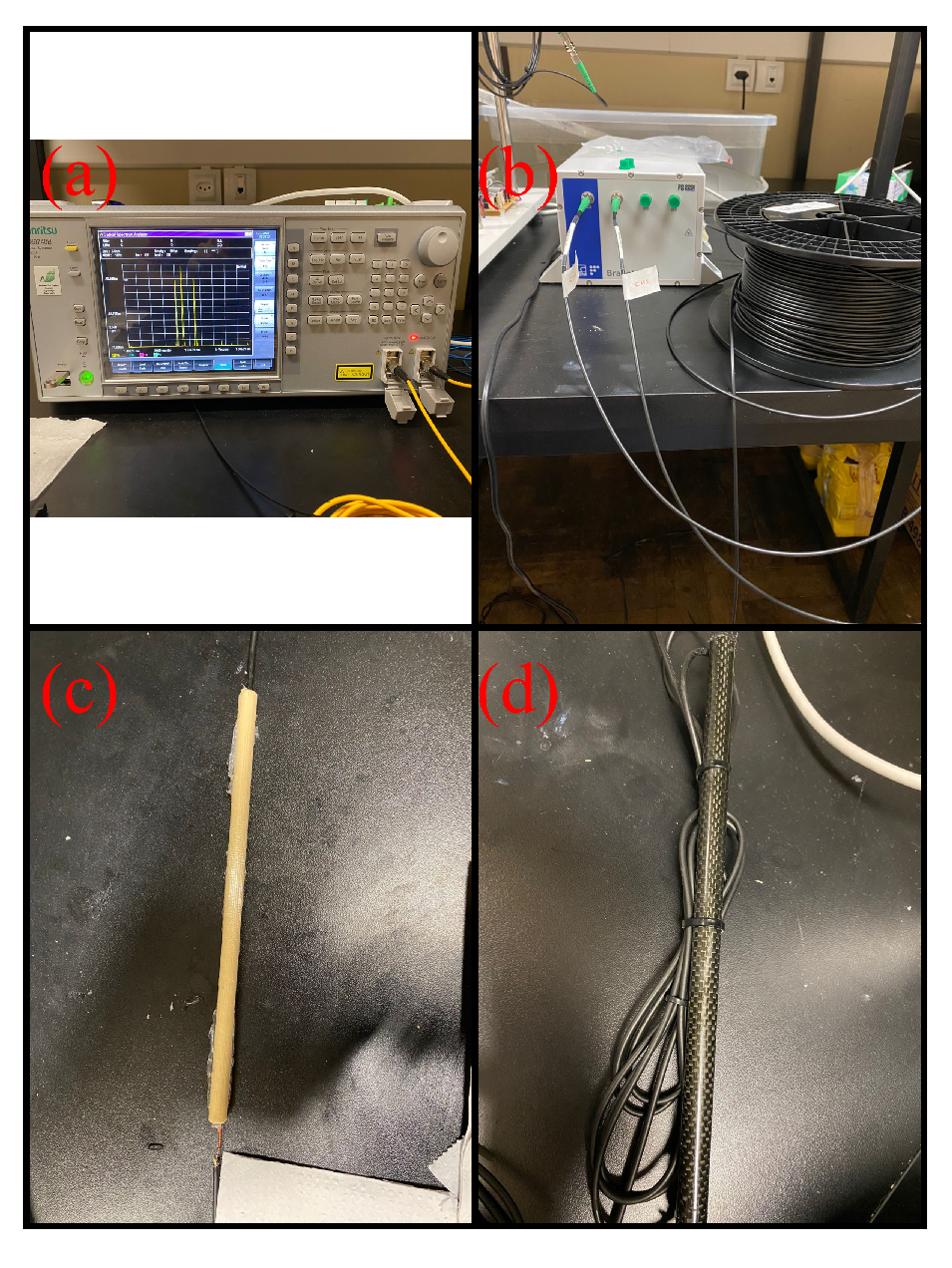

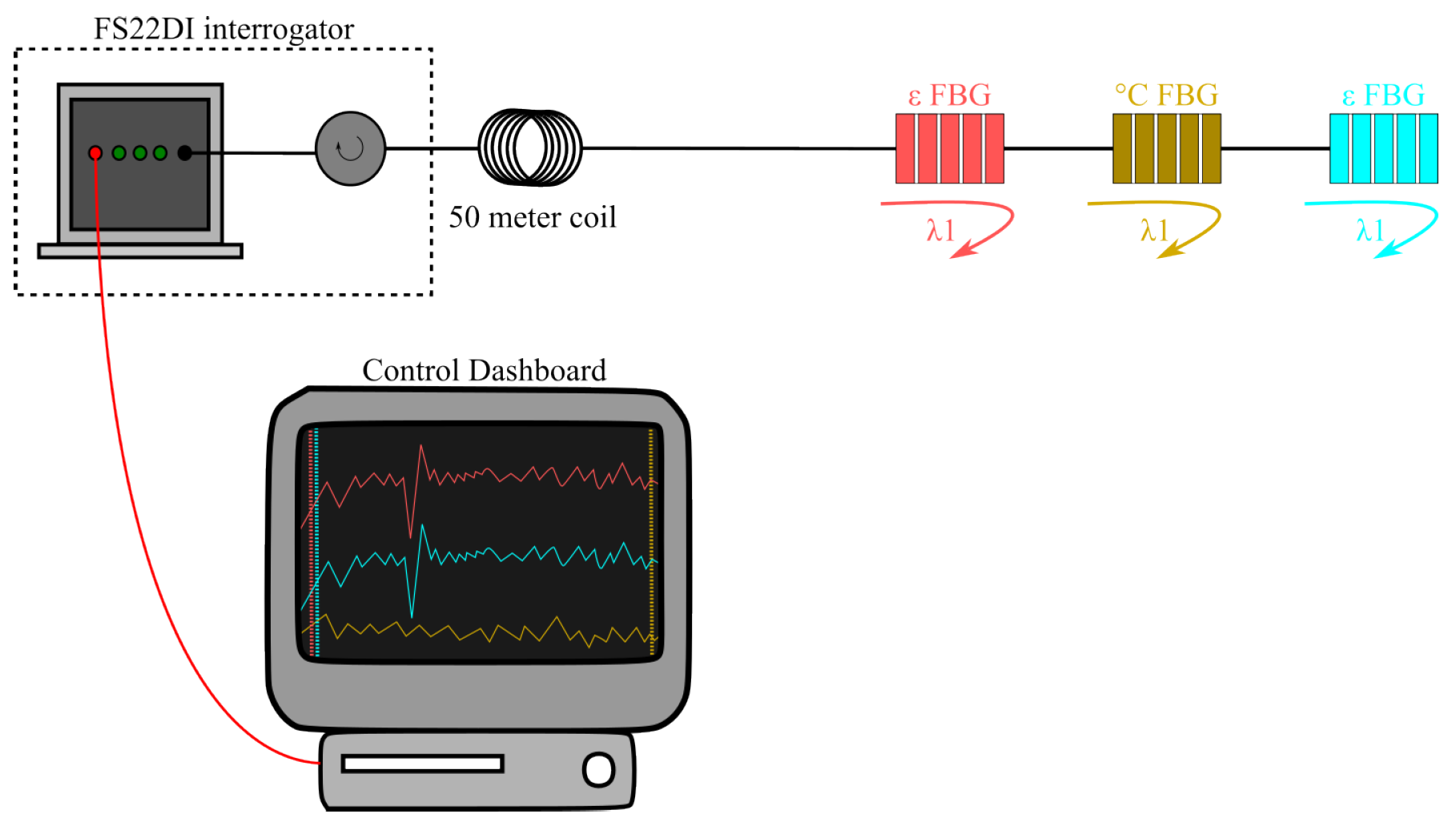
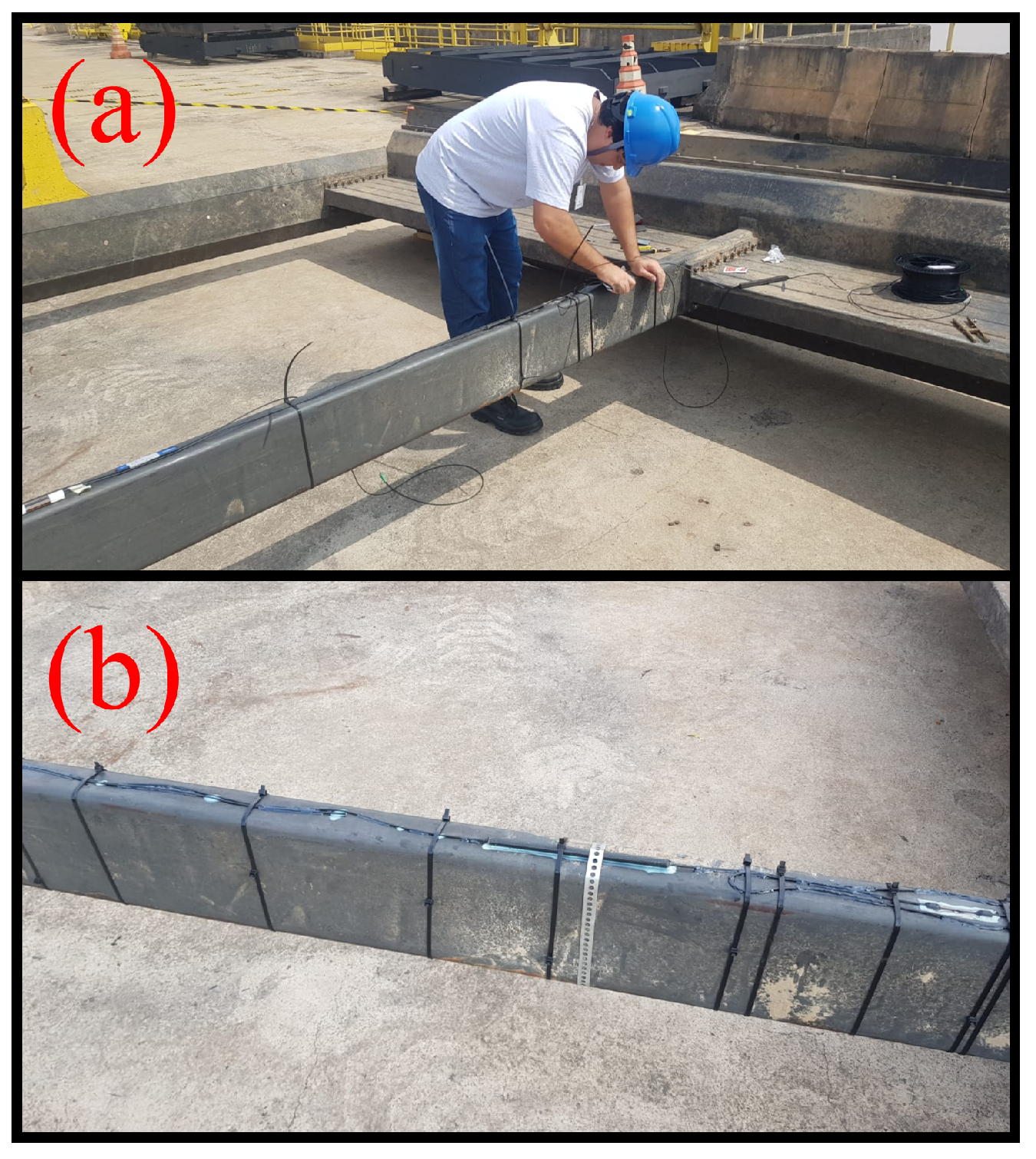
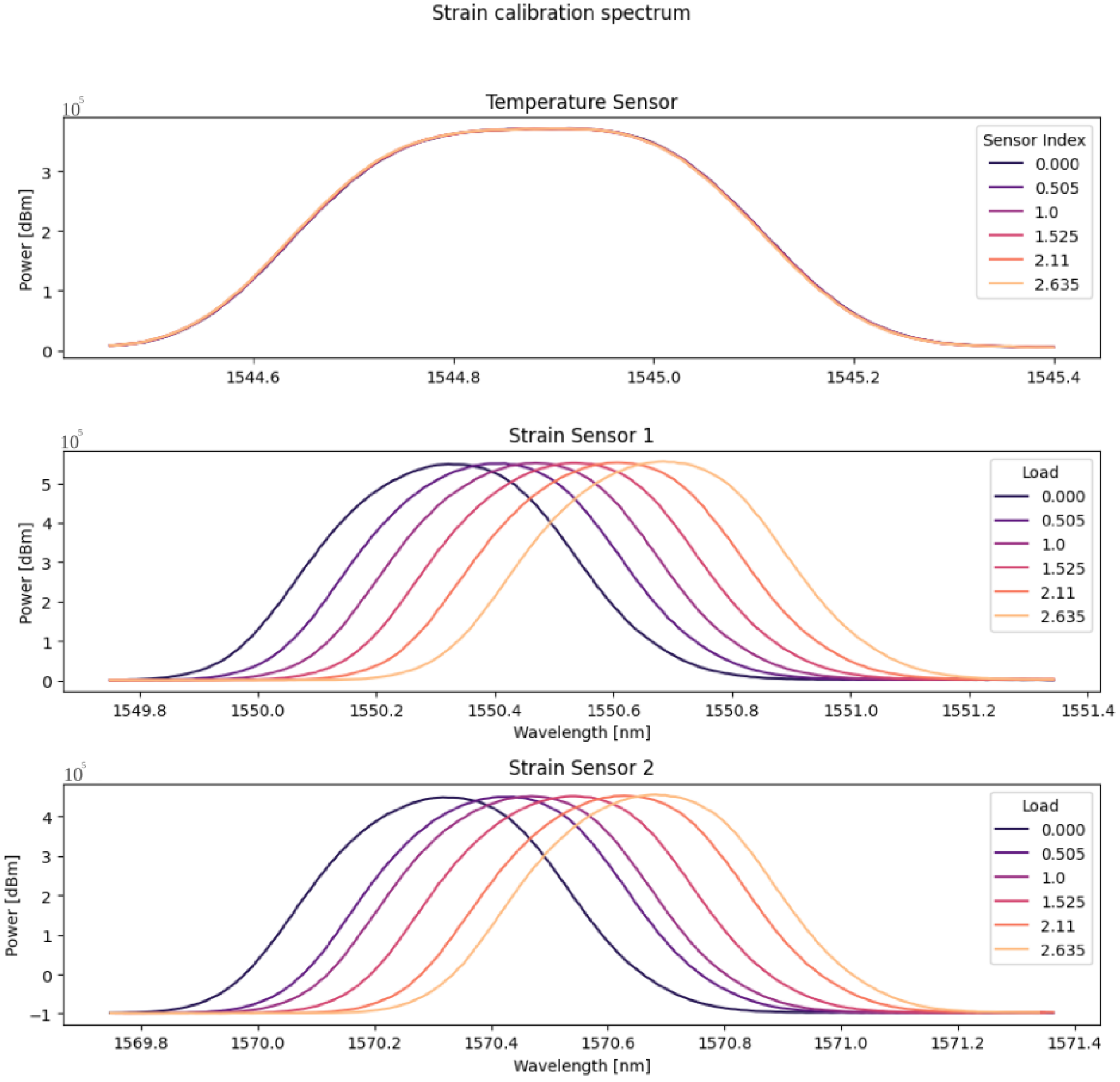
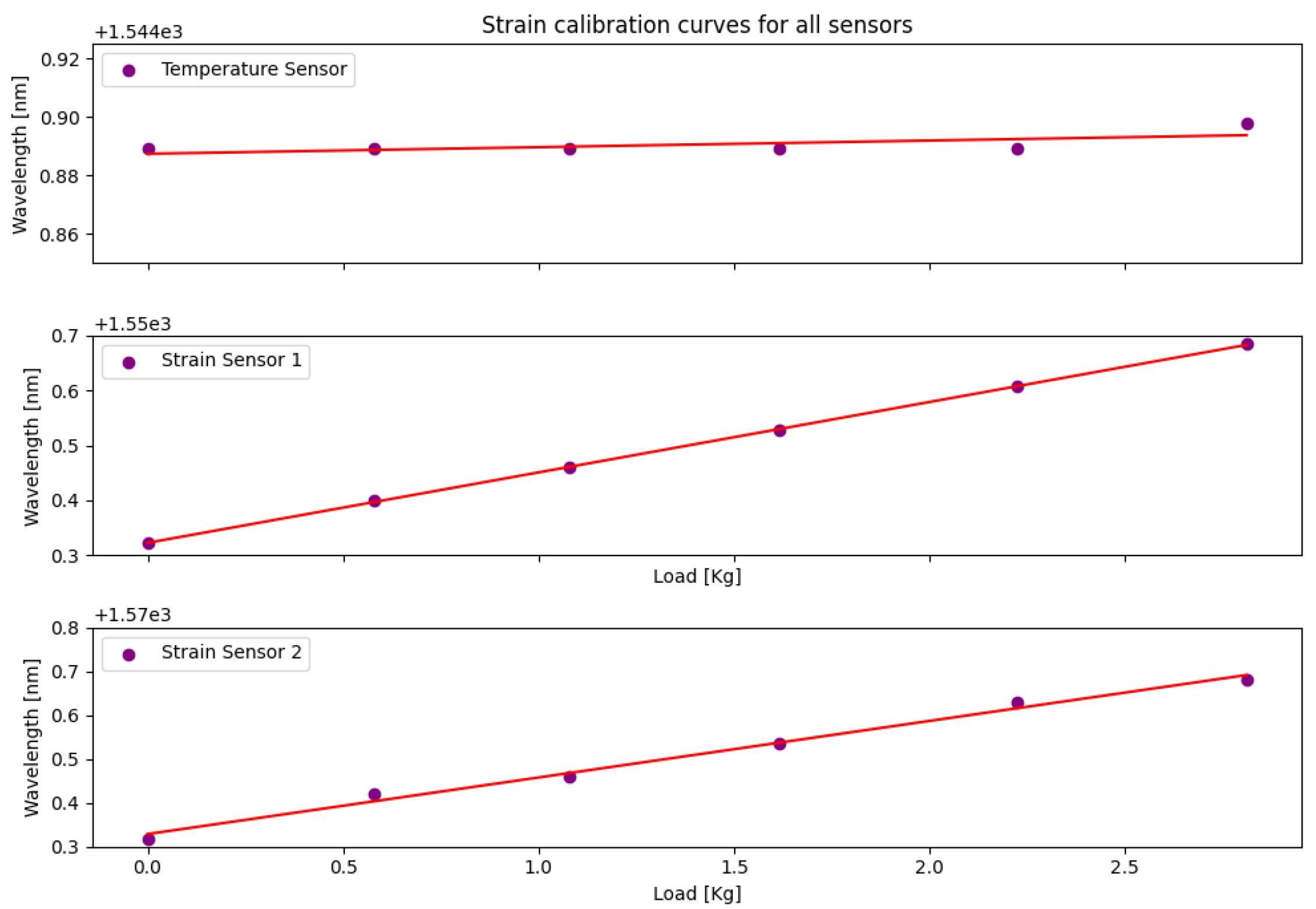
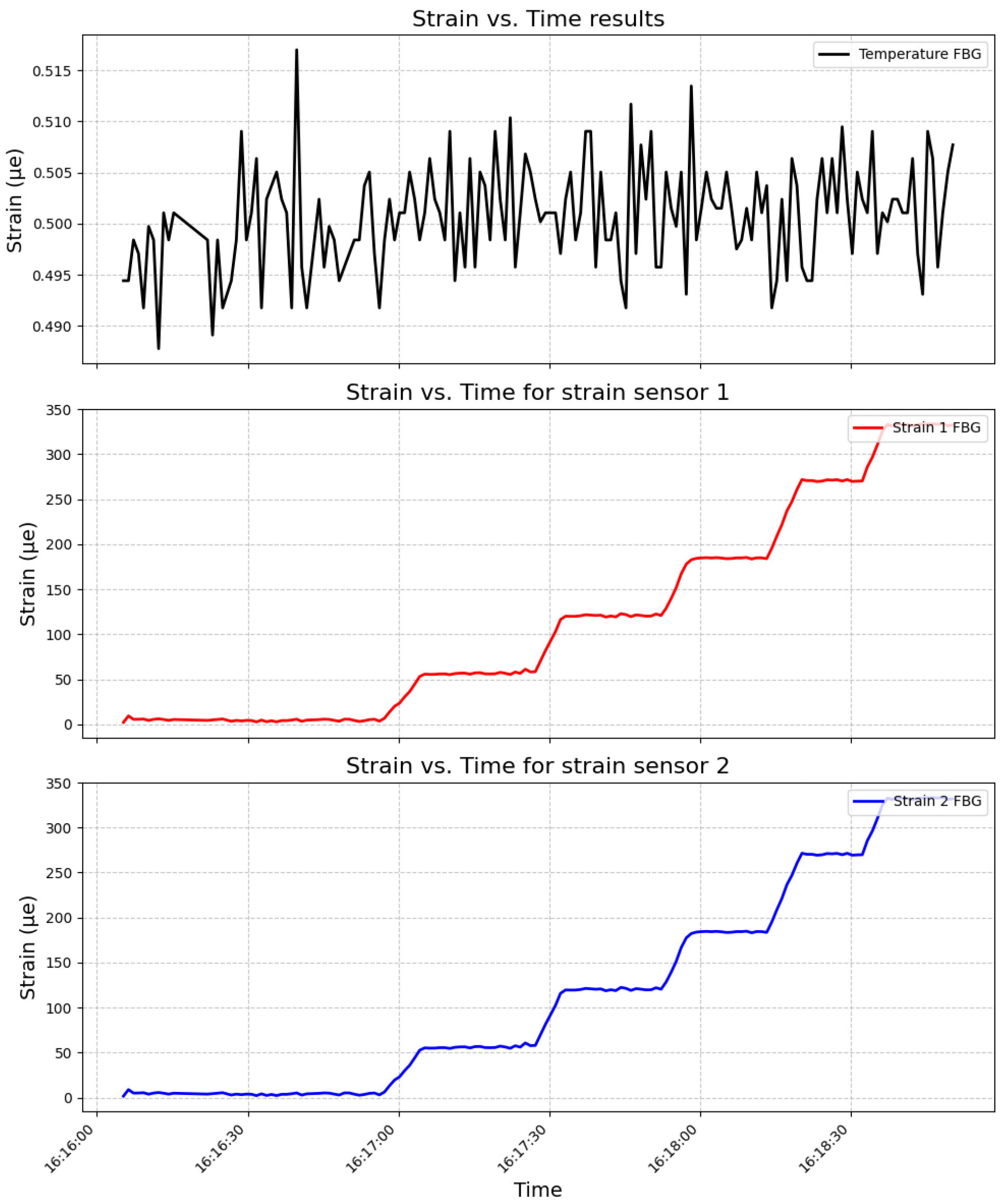




Disclaimer/Publisher’s Note: The statements, opinions and data contained in all publications are solely those of the individual author(s) and contributor(s) and not of MDPI and/or the editor(s). MDPI and/or the editor(s) disclaim responsibility for any injury to people or property resulting from any ideas, methods, instructions or products referred to in the content. |
© 2024 by the authors. Licensee MDPI, Basel, Switzerland. This article is an open access article distributed under the terms and conditions of the Creative Commons Attribution (CC BY) license (https://creativecommons.org/licenses/by/4.0/).
Share and Cite
Faraco, R.L.; Barino, F.; Campos, D.; Sampaio, G.; Honório, L.; Marcato, A.; Bessa dos Santos, A.; dos Santos, C.C.; Hamaji, F. Hydroelectric Plant Safety: Real-Time Monitoring Utilizing Fiber-Optic Sensors. Sensors 2024, 24, 4601. https://doi.org/10.3390/s24144601
Faraco RL, Barino F, Campos D, Sampaio G, Honório L, Marcato A, Bessa dos Santos A, dos Santos CC, Hamaji F. Hydroelectric Plant Safety: Real-Time Monitoring Utilizing Fiber-Optic Sensors. Sensors. 2024; 24(14):4601. https://doi.org/10.3390/s24144601
Chicago/Turabian StyleFaraco, Renato Luiz, Felipe Barino, Deivid Campos, Guilherme Sampaio, Leonardo Honório, André Marcato, Alexandre Bessa dos Santos, Clayton Cesar dos Santos, and Fernando Hamaji. 2024. "Hydroelectric Plant Safety: Real-Time Monitoring Utilizing Fiber-Optic Sensors" Sensors 24, no. 14: 4601. https://doi.org/10.3390/s24144601




